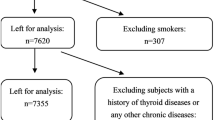Abstract
The incidence of goiter detected during pregnancy and its significance as an indicator of autoimmune thyroid disease after delivery was investigated in a sample of 707 pregnant women (81% in their 2nd trimester of gestation). Goiter was detected in 106 subjects (15%). Blood T4, T3, TSH, free T4 index (FT4I), antimicrosomal antibodies (AMA) and urinary iodine excretion were measured in these women and in a control group of gravidas without goiter. These measurements were repeated at 1 and 3 months after delivery. Compared with controls during pregnancy, subjects with goiter had lower FT4I values (11.0 ± 2.8 vs 9.0 ± 1.8; p < 0.01) and higher TSH values (2.9 ± 0.6 μU/ml vs 4.2 ± 2.1 μU/ml; p < 0.01). In contrast, T4, T3, AMA and urinary iodine excretion values were similar in both groups. In subjects with goiter FT4I values increased over pregnancy levels at 1 month (11.2 ± 2.0; p < 0.05) and 3 months (14.0 ± 3.0; p < 0.05) after delivery; in 29% a biochemical hyperthyroidism (FT4I > 13.5) was detected. During the same period TSH values decreased significantly (1 month: 1.9 ± 0.7 μU/ml; p < 0.05; 3 months: 2.7 ± 3.0 μU/ml; p < 0.05). Frequency of positive AMA increased from 8.6% during pregnancy up to 32.1% in the post-delivery period (p < 0.01). In the control group no variation in the FT4I, TSH or AMA were observed after delivery. These results indicate that goiter during pregnancy is common in Chilean gravidas and that it has predictive value for the appearance of autoimmune thyroid disease after delivery.
Similar content being viewed by others
References
Davies T., Cobin R. Thyroid disease in pregnancy and the postpartum period. Mount Sinai J. Med., 52: 59, 1985.
Gleicher N., Deppe G., Cohen C. Common aspects of immunologic tolerance in pregnancy and malignancy. Obstet. Gynecol. 54: 335, 1979.
Amino N., Kuro R., Tanizawa O., Tanaka F., Hayashi C., Kotani K., Kawashima M., Miyai K., Kumahara Y. Changes of serum anti-thyroid antibodies during and after pregnancy in autoimmune thyroid diseases. Clin Exp Immunol 31: 30, 1978.
Selenkow H.A., Brinbaum M.D., Hollander C.S. Thyroid function and dysfunction during pregnancy. Clin Obstet. Gynecol. 16: 66, 1973.
Ginsberg J., Walfish P.G. Post-partum transient thyrotoxicosis with painless thyroiditis. Lancet 1:1125, 1977.
Amino N., Mori M., Iwatani H., Tanizawa O., Kawashima M., Tsuge I., Ibaragi K., Kumahara Y., Miyai K. High prevalence of transient postpartum thyrotoxicosis and hypothyroidism. N.Engl. J. Med. 306:849, 1982.
Amino N., Miyai K., Onishi T., Hashimoto T., Arai K., Ishibashi K., Kumahara Y. Transient hypothyroidism after delivery in autoimmune thyroiditis. J. Clin Endocrinol. Metab. 42: 296, 1976.
Walfish P.G., Chan J.Y. Post partum hyperthyroidism. Clin. Endocrinol. Metab. 14: 417, 1985.
Perez C., Scrimshaw N.S., Muñoz J.A. Technique of endemic goitre surveys. Endemic Goitre, World Health Organization, Geneva, 1960, p. 369.
Irvine W.J., Standeven R.M. Serum triiodothyronine uptake using coated charcoal in the assessment of thyroid function. J. Endocrinol. 41: 31, 1968.
Dowling J.T., Appleton W.G., Nicoloff J.T. Thyroxine turn-over during human pregnancy. J. Clin. Endocrinol. Metab. 27:1749, 1967.
Amino N., Tanizawa O., Mori H., Iwatani Y., Yamado T., Kurachi K., Kumahara Y., Miyai K. Aggravation of thyrotoxicosis in early pregnancy and after delivery in Grave’s disease. J. Clin. Endocrinol. Metab. 55:108, 1982.
Tolino A., Conciliis B., Montenegro U. Thyroid hormones in the human pregnancy. Acta Obstet. Gynecol. Scand. 64: 557, 1985.
Burman K.D., Read J., Dimond R.C., Strum D., Wright F.D., Patow W., Earll J.M., Wartofsky L. Measurements of 3,3′, 5′-triiodothyronine (reverse T3), 3,3′-L-diiodothyronine, T3 and T4 in human amniotic fluid and in cord and maternal serum. J. Clin. Endocrinol. Metab. 43:1351, 1976.
Author information
Authors and Affiliations
Rights and permissions
About this article
Cite this article
Fardella, C., López, J.M., Valdés, M.E. et al. Autoimmune thyroid disease in the puerperium. Predictive value of thyroid enlargement and related hormonal changes occurring during pregnancy. J Endocrinol Invest 13, 283–286 (1990). https://doi.org/10.1007/BF03349563
Received:
Accepted:
Published:
Issue Date:
DOI: https://doi.org/10.1007/BF03349563




